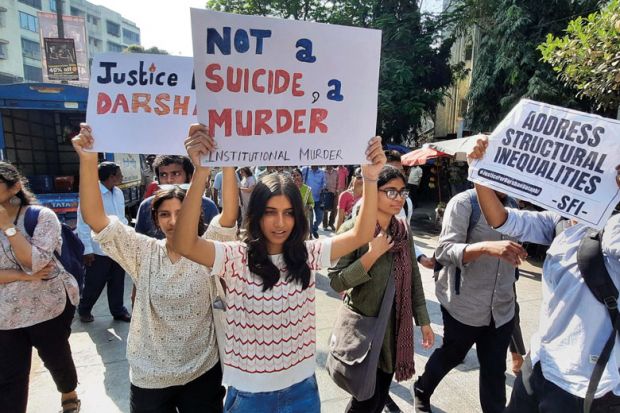The suicide of a Dalit student at a leading university in India has raised questions about institutional responses to caste discrimination and a call for empathy with the challenges faced by first-generation learners.
Darshan Solanki was an engineering student at the Indian Institute of Technology Bombay who died on campus earlier this year, three months into his studies. The son of a domestic helper and a plumber, he was the first in his family to gain access to higher education, through a place reserved for marginalised castes.
Mr Solanki’s family told local media that he had felt isolated from peers because of his caste. A statement by the student collective APPSC (Ambedkar Periyar Phule Study Circle) at the institution, said the case was “not a personal/individualised issue” but an institutional one.
Data presented to the Indian parliament in 2021 showed that, over the previous seven years, 56 per cent of suicides in central universities such as the IITs were students who belonged to lower castes, classes and tribal communities.
In early responses, IIT Bombay rejected claims of caste discrimination. After a two-week investigation, it published an interim report from a 12-member committee that interviewed 79 people. The report concluded there was “no specific evidence” of caste-based discrimination and noted that Mr Solanki’s academic performance had taken a downward turn in the second half of the semester, which could have affected him “seriously”.
Dheeraj Singh, an IIT Kanpur and IIM Calcutta alumnus and activist who focuses on caste and tribal issues in academia, said there was “not even an element of independence” in the report.
“Seven [of the committee] were professors, four were students, one was a medical doctor at the health centre at IIT,” he said. There was also “no element of expertise or competence on suicide or mental health issues”, he added.
“They [the committee] collectively ganged up and said we are giving a clean chit to ourselves,” Mr Singh said, referring to a local phrase for a certificate of exoneration. IIT Bombay declined to comment.
Prasad Chacko, a Dalit rights social worker, said he felt the report “betrayed a lack of understanding about the insidious manner in which caste discrimination operates”. He cautioned that Dalit students included in the inquiry may have felt under pressure about “the fear of reprisal and exclusion from the management and their colleagues”.
Beena Pullickal, the general secretary for the National Campaign on Dalit Human Rights (DAAA), pointed to the “larger question” about why higher education institutions did not take caste-based discrimination seriously.
“What forces young students from the Dalit community who have come from very vulnerable situations to take their own lives?” she asked, before adding, “this is something that these committees fail to address.”
A student at IIT Bombay, a first-generation learner who asked not to be identified, said that, unlike in a village where segregation on caste lines is obvious, caste discrimination could be more subtle in a university. Discrimination, the student said, was less about being ostracised in public spaces and more about peers and professors criticising reservation policies assigning places to lower-caste students, and about asking where an individual was placed in the entrance test to determine whether they benefited from a reservation and by extension whether they were from a lower caste.
It took time for first-generation learners to “develop a language” to articulate this discrimination, he added.
He asked for more institutional mechanisms or a defined department to be put in place, which students could approach for support in cases of discrimination, whether direct or indirect.
Mitesh Solanki (no relation), a master’s student at IIT Gandhinagar, is a first-generation learner who comes from a line of manual scavengers, an occupation involving the removal of untreated human excreta from sewers and tanks, a task allotted to lower castes, despite being banned.
He called for a change in the narrative about the plight of lower castes and classes in India, recalling a conversation with a journalist who took pictures of manual scavengers.
Mr Solanki asked the journalist to “click a picture of me and show it to other people who are working in these degrading conditions, saying that my father was also a manual scavenger – but see, I am here in IIT. I’m in a good place, so it is possible for you also to get into a good place.”
A PhD student from IIT Bombay, who asked to remain anonymous, said that the news of a fellow lower caste’s death in his university had kept him up all night. “I didn't know the person directly. But I felt like this is a systematic failure because we were pushing for something and we couldn’t do enough.”
A week after Darshan Solanki’s death, the chief justice of India, D.Y. Chandrachud, spoke at the graduation of a top law school in south India.
“The incidents of suicide of students from the marginalised communities are becoming common,” he said. “These numbers are not just statistics; they are stories sometimes of centuries of struggle.
“Practices such as putting out a list of marks obtained by students along with social categories, asking for marks of marginalised students to publicly humiliate them, making a mockery of their English proficiency and labelling them as inefficient should end,” he said as he called for urgent, systemic reform.
Register to continue
Why register?
- Registration is free and only takes a moment
- Once registered, you can read 3 articles a month
- Sign up for our newsletter
Subscribe
Or subscribe for unlimited access to:
- Unlimited access to news, views, insights & reviews
- Digital editions
- Digital access to THE’s university and college rankings analysis
Already registered or a current subscriber? Login








